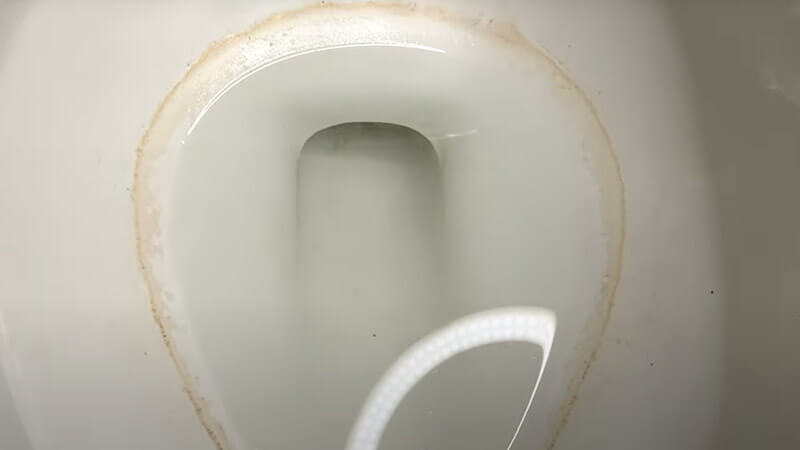Everyone tends to feel embarrassed to see and talk about the yellow water in the toilet. Also, it creates an unhygienic and dirty environment. And people often wonder why is my toilet water yellow!
Well, it’s the most common occurrence many homeowners face. So, don’t get panic when the plumbing system is malfunctioning.
However, there can be many causes for this problem, like mineral buildup and bacteria growth. And I will explore all of them in this comprehensive guide.
Let’s dive in and find the problems and solutions together in the section below–
Possible Reasons Why is the Toilet Water Yellow
The reason behind the yellow water can vary, you can check the issue one by one and detect the actual problems by investigating. Therefore, here I have mentioned some of the main causes of yellow water in the toilet.
Take a look at them–
1. Hard Water Residue and Minerals
It turns out that the majority of household water supplies around the world are not as clean as we believe them to be. In fact, the hard water that comes from these sources is comprised of various minerals such as magnesium, manganese, zinc, and among others.
But having a small amount of these minerals is not dangerous. Nevertheless, some of these minerals accumulate on the inner surface of your pipes gradually. When the accumulation becomes too much, some parts of it will detach and mix with the water whenever you flush.
And that causes your toilet water to turn yellow. Therefore, this is the main explanation behind the discoloration of toilet water.
As a result, those mineral mixtures remain on the walls of your toilet, mainly if you clean them infrequently.
2. Rusting Bolts in Your Cistern
Some components of your toilet tank, including the metal bolts, can rust over time due to constant contact with water. As a result, the rusted bolts can cause the water in the tank to turn a dirty reddish-yellow or brown color. When you flush, this discolored water can emerge in the toilet bowl.
3. Rusting Pipes
If your house is an older construction, its water pipes may be composed of iron. When these pipes erode, they can cause the water to become discolored, ranging from yellow to dark brown or even red.
Then replacing all of the iron pipes in your home will be necessary to prevent rust from contaminating your water.
4. Standing Water
Standing water refers to any water that remains stationary and does not move. It can also be mentioned as stagnant water. For instance, if you leave your house unoccupied for a prolonged period, you might discover that the water in your toilet has turned yellow due to stagnation.
In addition to the discoloration, stagnant water that appears yellow emits an unpleasant odor because of the buildup of bacteria. Furthermore, the accumulation of dust also plays a role in causing discoloration.
5. Water Softener Creates Yellow Water
If you have installed a water softener to treat hard water in your home, you may notice a change in water color resulting in yellowish toilet water. And a potential indicator of the cause could be the recent water softener installation.
6. Rusting of Galvanized Steel
Galvanized steel and iron pipes are used in plumbing systems in houses, while PVC pipes are used in modern houses. While there are several advantages to using these types of pipes, the primary disadvantage is that they are prone to rusting on the inside.
And water is supplied through iron pipes which gather rust over time. However, when high water pressure is used, the rust particles are dislodged from the pipes. And it gathered in the toilet tank, causing a deep yellow color in the interior of the toilet bowl.
7. Sewer Lines
Occasionally, sewage pipes may become blocked, causing polluted water to enter the clean water supply. When you notice any unpleasant odors or discolored yellow or brown water, it is essential to check if it has been contaminated by sewage or wastewater.
8. Water Repairs
If repairs are happening to the water supply lines in your city, you might notice that the water turns yellow. The reason behind that can be built-up sediments from your neighbor’s water lines or your home. And it can be stirred up during the repair process.
In some regions, water lines are flushed to remove accumulated dirt and contaminants, which may lead to discolored water reaching your fixtures. If this is the reason for your yellow or discolored water, simply letting the water run for a few minutes should clear it up.
9. Contaminated Water
One potential explanation for the yellow color of your toilet water could be pollution from the water supply in your area. Sometimes, the water that enters your bathroom’s plumbing may combine with sewage in the building’s sewer system.
If the water in your bathroom is polluted, it can lead to the development of yellow water in the toilet bowl.
10. Iron in the Water
Another reason can be that water in your toilet appears yellow, the high level of iron present in the water source before it enters your home. Although minerals may naturally exist in your water, a high concentration of iron can cause the water to turn yellow.
If you notice rust-colored stains forming on bathroom fixtures, such as the faucet, it may indicate that your water has a high iron level.
11. Toilet Tank
In case you don’t find discolored water in any other part of your house, the source of the yellow water could be your toilet tank. Typically, iron bolts keep the toilet tank in place, and these bolts can start rusting, leading to yellow water.
To check if the toilet tank bolts are causing the discolored water, examine the inside of your toilet tank.
12. Wear and Tear on Toilets
Last but not least, a common issue that should not be overlooked is toilets that have become old and worn out. Using your toilet bowl regularly without proper cleaning can result in an unsightly yellow ring forming inside it.
So, show your toilet some care, scrub the corners meticulously, and flush them out regularly.
How to Get Rid of Toilet Yellow Water?
No one likes yellow water in the toilet although it’s not that much harmful. Fortunately, there is some remedy you can apply to eliminate this issue permanently. I will provide some effective recommendations in the section below. Read thoroughly.
Remove Rust on Toilet Tank Bolts
Inspect the bolts on your toilet tank by using a flashlight to determine whether they have rusted. If you observe significant rust on the bolts, you will see that the water has a reddish-yellow appearance.
To tidy it up, just scrub the bolts with a firm brush with stiff bristles. With some effort and the brush, you should be able to eliminate the rust.
Therefore, changing those with new ones may be necessary if the rust proves too challenging to eliminate using only a brush.
Replace the Pipe Fittings
You will need to replace the old pipe fittings with new ones to fix the issue of yellow water in the toilet caused by rusty pipes. This differs from the problem of rusted bolts on the toilet tank, which can be removed.
Do you need the services of a plumber for this task? I suggest you hire a professional plumber to install new pipe fittings, even though it may cost more than cleaning the rusty components. However, the expense is justified because of work quality, which is worthwhile.
Scrub the Mineral Buildup
As time passes, minerals can accumulate on the toilet bowl’s surface and inside the cistern. And regularly cleaning these mineral deposits can prevent the water in the toilet from turning yellow.
However, you can identify the areas where mineral buildup has occurred and remove them by using a brush with stiff bristles and scraping them.
To complete the cleaning process, flush the toilet three times to prevent scraped minerals from accumulating in the cistern. For the inside of the toilet bowl, use a bristle brush along with toilet cleaning detergents to thoroughly clean it.
And I will mention a few toilet cleaning products below–
- Baking soda + vinegar is a perfect combo
- Lemon juice + essential oils
- Vinegar and borax
- Coca-cola
- WD-40
- Borax pastes
- Bleach
Final Words
By identifying the main cause of a yellow water toilet, you can take steps to fix it and restore your toilet’s normal color. And following above mentioned reasons, you can address and solve the complication effectively.
Therefore, regular maintenance can help prevent yellowing and keep your toilet water in top condition. So, I hope the common question of why is my toilet water yellow has run away from your mind.
FAQ
Why does my toilet water get yellow so fast?
How do I keep my toilet from turning yellow?
What are the signs of hard water?
What bacteria causes yellow water in the toilet?
Ellen Franz is an award-winning home designer whose work has been featured in numerous publications. In addition, he has collaborated with some of the industry’s most influential members. Ellen’s experience as a designer and his ability to understand the needs of her clients makes him a perfect fit for The Home Expert. Ellen is also well-known for his expertise in furnishing and remodeling.

